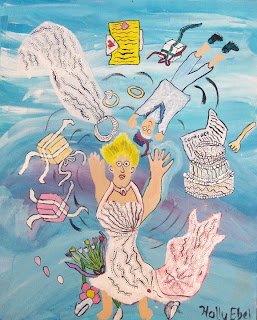There's a show of works by Visionaries & Voices (V&V) artists at the Cincinnati Art Museum up through the end of January, 2011. Here's the way it's marketed: "Love is an important part of the lives of the artists at V&V and continually influences their decisions and their futures. Bride & Groom Collide provides an opportunity for artists with disabilities to express their honest opinions, their ideas, and their dreams about forging a loving relationship. More than 40 V&V artists have revealed their personal beliefs on the subject for the exhibit, and have created new paintings, sculptures, and drawings that are insightful and emotionally powerful. The artwork in the exhibit, as does most work by self-taught artists, has noticeable influences by the American folk art and the abstract expressionism movements."
Some of the works are lovely, some are beautifully weird, and some are not that good. That's probably a taboo thing to say, but I've earned my status as taboo-breaker. I helped start this whole V&V thing, and participated in curating many shows like this one at the Art Museum. Every time I did this, I told myself that it's a chance for "self-taught" or "outsider" or "visionary" artists with disabilities to have their work shown in a space that usually would exclude them, as they don't have access to networking opportunities and art-school, etc. But each time I curated shows like "Bride and Groom Collide," I always heard this voice inside my head, a doubting, whiny one, whispering little asides about how I was helping to ghettoize the art and artists even while I was helping to show their works in a great venue (and by great venue I mean, like this show, in the back stairwell at the Cincinnati Art Museum, not the main gallery, but still it's close).
This voice was telling me that "grouping" artists because they have a disability somehow makes "disability" the focus of the way we perceive the works, and therefore diminishes the juice and excitement of viewing the art. There's no mystery here, no cacophony, just harmony. The marketing notes hammer that home: it's about "artists with disabilities expressing their honest opinions, their ideas, and their dreams about forging loving relationships" through "paintings, sculptures, and drawings that are insightful and emotionally powerful."
The literal "expressing" about marriage and love and brides and grooms though comes through mostly in quoted text next to the works, attributed to the artists who made each piece, sort of like a documentary of what love and marriage mean to "people with disabilities." The quotes are great and funny and insightful, as advertised, but again the point is underlined so thickly as to eliminate any other possibilities. The trials and tribulations of love are complicated by the disability in everyone's lives of course, and the universality of that issue is duly noted, but this is not an art show as much as a show of artists with disabilities using art to exemplify an issue: love is an important part of people's existences.
Any group show with a "big" theme like that can get on your nerves, of course: themes notoriously undermine the strangeness and richness of art, taking something huge and odd and gorgeous and often shrinking it to fit into a neat little category. But a group show featuring "artists with disabilities" as the main categorization has two big albatrosses around its neck: trying to break free from the way most people view "disability" and also trying to deconstruct the way we lazily consume art by assigning it into categories we can check off and then leave behind in the first place.
"Bride and Groom Collide" has blissful moments, but not because of the pedantic subject matter; it's more because some of the chosen pieces break free of the theme and allow us a moment of respite from the heavyhandedness.
The two pieces below do this for me. The top is by Holly Ebel, and the bottom by Marci Rosen. Joyous, a little cynical, kind of weird. Ebel's piece is a merging of Finster and Chagall with Saturday morning cartoons back when they were really cool. Rosen's has a jittery, unnerving graveness, a dark little laugh inside each eye.


No comments:
Post a Comment